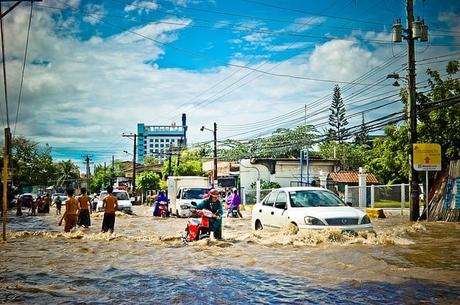Three times more people than previously thought could be under threat from rising seas by 2050, and that poses a danger to all, including erasing some of the great coastal cities worldwide, according to new research.
A more accurate way of calculating land elevation has been developed by the authors of a paper published on Tuesday that was based on satellite readings. As it was a standard way of estimating the effects of sea-level rise over large areas, the previous numbers were found far too optimistic. The land on which around 150 million people are now living will be below the high-tide line by mid-century, new research shows.

Southern Vietnam could all but disappear.
The earlier expectations were of submerged land by 2050 as per the first map. However, the new outlook, which means a second map indicates that the country’s bottom part will be underwater at high tide.
In Vietnam, almost one-quarter of the population totaling 20 million people and more living on land will be inundated.
According to the research produced by Climate Central, a science organization based in New Jersey, much of Ho Chi Minh City, the economic center of the nation, would disappear with it, and that got published in the journal Nature Communications. However, the projections do not include future population growth or loss of land due to coastal erosion.
Scott A. Kulp, a researcher at Climate Central and one of the paper’s authors said, standard elevation measurements using satellites involve struggling for differentiating the actual ground level from the tops of trees or buildings. Therefore, he, along with Benjamin Strauss, Climate Central’s chief executive, determined the error rate and corrected it using artificial intelligence.
The earlier technique estimated that just 1 percent of citizens who now live on land are likely to be inundated by 2050 in Thailand, whereas the new method showed the number would be more than 10 percent. Bangkok, the political and commercial capital, is particularly exposed to peril.
As per Loretta Hieber Girardet, a Bangkok resident and United Nations disaster risk-reduction official, climate change will put pressure on cities in many ways. As global warming floods more places, instead of working on the land, poor farmers will seek work in cities.
“It is a dire formula,” she said.
Similarly, Shanghai, one of Asia’s most important economic engines and many other cities around it, will be under threat from water.
As per the new data, 110 million people already live in places that are below the high tide line, and Mr. Strauss attributes those to protective measures like seawalls and other barriers. Mr. Strauss said cities must invest higher sums in such defenses quickly.
However, even if the investment is made, defensive measures cannot go too long. Mr. Strauss cited the example of New Orleans, a city below sea level that was devastated during Hurricane Katrina in 2005 when its extensive levees and other protections did not work. “How deep a bowl do we want to live in”? He asked.
Mumbai, India’s financial capital, and among the largest cities in the world could be wiped out, the new projections suggest, the historic downtown core of the city is particularly vulnerable.
Dina Ionesco of the International Organization for Migration, an intergovernmental group that coordinates action on migrants and development said, the overall research suggests that countries should start preparing now for the relocation of more citizens internally.
“We’ve been trying to ring the alarm bells,” Ms. Ionesco said. “We know that it’s coming.” There is a little modern precedent for the required scale of population movement, she added.
The disappearance of cultural heritage like Alexandria, Egypt, founded around 330 B.C. by Alexander the Great because of rising waters could bring its kind of devastation.
In other places, the regional conflicts could be aggravated due to migration caused by rising seas.
Iraq’s second-largest city, Basra, could be mostly underwater by 2050 and the effects could be felt well beyond Iraq’s borders, according to John Castellaw, a retired Marine Corps lieutenant general who was chief of staff for United States Central Command during the Iraq War and now on the advisory board of the Center for Climate and Security, a research and advocacy group in Washington.
He added, further loss of land to rising waters there “threatens to drive further social and political instability in the region, which could reignite armed conflict and increase the likelihood of terrorism.”
“So this is far more than an environmental problem,” he said. “It’s a humanitarian, security, and possibly military problem too.”

